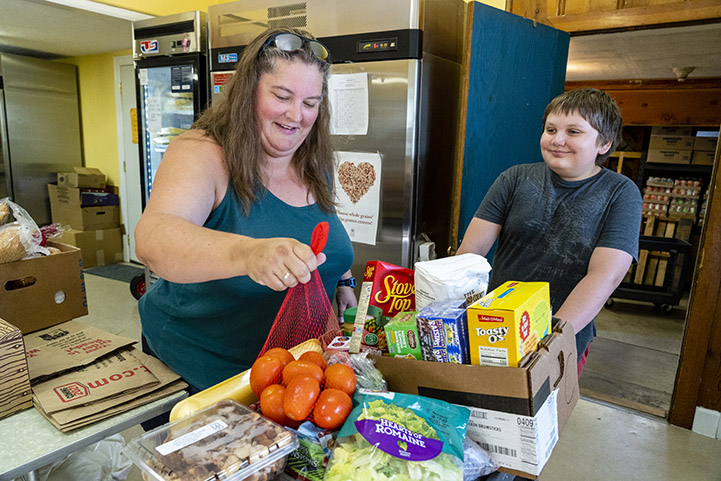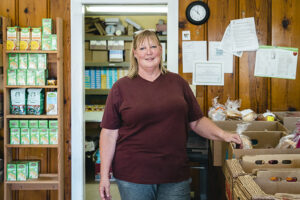Pantry aids Santiam Canyon residents through recovery

Stacy W. and her son Graeson shop for food at the Mill City/Gates Community Assistance Center. Before it was destroyed by wildfires in 2020, a family farm provided ample food for Stacy and her family.
When wildfires tore through Santiam Canyon on Labor Day in 2020, the resulting loss was devastating. Whole communities were nearly destroyed, more than 1,500 buildings were gone and thousands of residents were displaced from their homes and properties.
Two years later, many canyon residents are still working through a long and difficult recovery. While some have rebuilt burned homes, many people whose homes burned are still living in trailers or recreational vehicles as they navigate the complexities of insurance, permitting, utilities, and supply chain issues.
“It is a never-ending process. It’s tiring every day, every single day,” says Stacy N., who lost the house near Mill City that she shared with her husband, their two daughters, a son-in-law and two grandchildren.
In addition to the logistical challenges of rebuilding homes and dealing with the emotional trauma of losing almost everything, life in a trailer presents its own unique difficulties, including cramped spaces, greater susceptibility to extreme temperatures and a dearth of food storage capacity.
That’s why food pantries like the Mill City/Gates Community Assistance Center have been so crucial to helping Santiam Canyon communities rebuild and recover. With few options for fresh food nearby, residents like Stacy N. – who served as a pantry volunteer before the fires and became a client after they destroyed her home – are relying on the Food Share’s partner pantries to keep their shelves stocked with fresh items that are not readily available in their rural communities.
“There is [a grocery store] up here, but I haven’t been in because it’s so expensive. I usually just try and shop in Albany or Salem once every few weeks, but prices are going up constantly,” says Stacy N., who before the fires hadn’t imagined needing to rely on the pantry for food.
Between a big garden, a well-stocked canning closet and a freezer full of meat and fish hunted and caught by her husband, Stacy N.’s family always had about a year’s worth of food on hand.
“After the fires, we didn’t have a freezer, we didn’t have the room to put anything anywhere,” she says. “So this [pantry] has really helped us.”

When Stacy N. and her family lost their homes in the 2020 wildfires, she began relying on food from the Mill City/Gates Community Assistance Center.
Like Stacy N., Mill City resident Stacy W. was also self-sufficient in providing food for her family before the fires destroyed their farm. At her parents’ property in Lyons, the family grew all manner of vegetables, had a canning pantry stocked with over 1000 jars, raised chickens and had an apple orchard.
“We were at the point where, produce-wise, we were pretty able to self-sustain,” she says. “We grew tomatoes, beans, corn, peppers…the ground is not capable of doing that now. There’s too much ash, too many rocks, all the nutrients that we added are gone.”
Stacy W.’s family escaped the fires unharmed, but her father passed away three months later. “Fifty years’ worth of stuff gone and he couldn’t do anything about it, that was it,” she says, “but I’m glad he didn’t have to struggle through getting the house rebuilt.”
Her mother now lives in a new home on the property, and the family is almost back to where they can think about growing food again. It will take a lot of work to clear out all of the rock that was dumped on the land when new foundations, septic systems and water lines were excavated. For now, Stacy W. is relying on the pantry for the healthy foods that the land provided for her family before the fire.
“It’s been amazing being able to have that produce either to eat immediately or to [preserve] for future eating,” she says. “My kids look forward to coming down here to get fresh apples, oranges, or whatever else is here.”
For Susann, one of many dedicated volunteers that helps run the pantry, the idea is to support her neighbors through the recovery, for as long as it takes, up to and including when they move into their new permanent homes. When folks finally do have a full kitchen with sufficient storage space, the cost to restock their refrigerator, freezer and cupboards can be overwhelming. Susann and her fellow volunteers want to make sure the pantry is there to help.
“We bring them in and say, ‘okay, what can you put in your pantry? What do we have that we can put in your pantry so you don’t have to go out and buy everything to start?’,” she says. “And that makes a big difference.”
Your support helps pantries like Mill City provide nutritious food to families who are rebuilding and recovering. Thank you.


